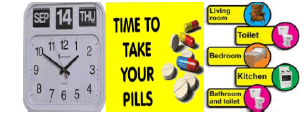Dementia Care at Home (Move the Knowledge not the Patient) - A Community Case Study
Received: 13-Jun-2019 / Accepted Date: 26-Jun-2019 / Published Date: 03-Jul-2019 DOI: 10.4172/2161-0460.1000469
Abstract
Dementia patients are often cared in institutional setting leading to substantial economic burden for the public health sector and family caregivers. The home-based care by a community psychiatry team may be a useful method of treatment delivery. In-home care includes a wide range of services provided in the home, rather than in a hospital or care facility. It can allow a person with dementia to stay in his or her own home. It also can be of great assistance to caregivers. Not all in-home services are the same. Some in-home services provide non-medical help, such as assistance with daily living. Other in-home services involve medical care given by a licensed health professional, such as a nurse or physical therapist.
Keywords: Dementia; Community care; Non-pharmacological
Introduction
Dementia is a progressive major neurocognitive syndrome disorder (group of signs/ symptoms) characterized by neuropsychological impairments, reduced ability to perform activities in everyday life and Behavioral and Psychological Symptoms of Dementia (BPSD) [1]. These deficits cause significant impairment in social or occupational functioning and represent a significant decline from a previous level of functioning. However, it has been seen that dementia patients are often cared in institutional setting, which is a substantial economic burden for the public health sector as well as for family caregivers [2,3]. The department of psychiatry, PGIMER Chandigarh provides community care services at Nandpur Kalor village every Saturday by a community psychiatry team (Consultant, senior and junior resident, social worker). We hereby report a case for which community-based dementia care was provided by a specialist’s team through weekly home visit.
Case Description
A 65-year-old male, with history of alcohol and tobacco dependence in the past was evaluated at home upon request of family members. On history taking, patient was reported to have developed a gradual change in behavior characterized by forgetfulness, impaired attention, talking excessively, anger outbursts, urinary and fecal incontinence over a period of 5-6 months. This was followed by a sudden worsening after a bout of fever, leading to increased sleep, decreased appetite, hallucinatory behavior, confusion and disorientation to time, place and person. He was evaluated at this time by community psychiatry team, diagnosed to have possibility delirium superimposed on dementia. He was started on Tab. Quetiapine 25 mg BD. Family members were advised to get the baseline investigations along with MRI done which was found with in normal limit. There was an improvement in symptoms of confusion and sleep disturbance over a period of one week. Thereafter, patient continued to show the previously mentioned symptoms. In addition, he would try to take off his clothes not caring about presence of family members, would ask his wife for sexual intercourse repeatedly which would be distressing for family members. Then he was evaluated, on Mini-Mental State Examination (MMSE) score was 11/30, Neuropsychiatric Inventory (NPI) score was 72/144. He was diagnosed as dementia with behavioral and psychological symptoms and started on Donepezil 5 mg and Memantine 5 mg with monitoring of side effects. These symptoms gradually decreased, with improvement in self-care and anger outbursts over the next 3-4 months. The non-pharmacological management was divided into three strategies namely theoretical, behavioral and psychological training of patient and care givers [4,5]. To accomplish this home visits started by the community psychiatry team first weekly for 3 months then fortnightly for next 3 months (with telephonic contacts in between). In the first stage psycho-education sessions for care givers were taken as a part of theoretical training in which family members were educated about the nature of illness, course and need of treatment and role of family members as co-therapist.
Discussion
To address challenging behavior approach to behavioral management was started as a part of behavioral training. The general strategies for managing behavioral symptoms taught to the care giver as shown in Tables 1 and 2.
| Domain | Strategies applied |
|---|---|
| Caregiver education and support |
• Behaviors not intentional |
| • As disease progress, need guidance and cueing for completing tasks | |
| • Go along with patient and avoid arguing/trying to reason/ convince | |
| • Take care of self, practice healthy behaviors with doctor advice | |
| Positive environment Created |
• A separate safe room ensured to avoid wandering (buzzers put on doors, adequate light provided, measures taken to reduce fall risk) |
| • Clutter or unnecessary objects removed | |
| • Labeling and visual cues reminders applied (arrows pointing to bathroom) | |
| Communication skills taught |
• Give sufficient time to patient to respond to a question |
| • Offer simple choices (no more than 2 at a time) | |
| • Help the patient to find words so that he can express feelings | |
| Tasks simplified (ADLS/IADLS) (Wife supervised) |
• Mobile number dialed by wife and ask the patient to talk |
| • Each task broke into simple steps | |
| • Verbal or tactile prompt were used for each step | |
| • Structured daily routines that was predictable provided to caregivers |
Table 1: General strategies for managing behavioral symptoms.
| Domain | Representation | Strategies applied |
|---|---|---|
| Forgetfulness |  |
• Avoid confusion about time and dates |
| • Objects labeled in patient language (grooming, bathing) | ||
| • Medications checklists made and supervised by wife | ||
| Restless/ walking, wakes caregiver at nighttime |  |
• Sleep hygiene taught |
| • Daytime naps avoided | ||
| • Encouraged for daytime activities | ||
| • Beverages like tea/coffee avoided | ||
| Sexual comments, Inappropriate touching, Incontinence, repetitive questioning |  |
• Use calm, reassuring voice |
| • Don’t confront, say NO | ||
| • Distraction technique taught | ||
| • Massage (rubbing, brushing mostly on the back), hand massage of each hand with verbalization | ||
| • Listen old Punjabi songs/ videotapes/audios |
Table 2: General strategies for management of problematic behavior.
As a part of psychological training, the role plays session taken about several situations putting the care givers in the patient’s place to improve the feelings and reactions of their relatives. During the sessions, care giver distress was addressed and stress management strategies taught. It was also educated to family members/caregivers that this initial improvement would last for months then again some gradual decline would continue. So they have to keep applying the behavioral techniques as per the need arising. To increase the level of wellbeing, cognitive stimulation therapy was started by using household materials, family pictures and old newspapers to stimulate memories. Within 2 -3 months improvement occurred, patient started taking care of himself and call care givers whenever needed. His participation in activities of daily living like bathing, brushing, wearing clothes, toileting, aggression, leisure activities like playing cards, listening music, helping in taking care of cattle, social disinhibiting behaviors as well as bio functions improved. His problematic behaviours also reduced. So, the initial improvement in superimposed delirium occurred after pharmacotherapy but the behavioural and psychological base line symptoms of dementia improved gradually after non pharmacological home based intervention.
In index case the family members reported that they perceived a need for treatment since the onset of symptoms but were unable to understand whom to consult. So there was delay in treatment as they felt patient could not be taken for a consultation due to his behavioral disturbances which they could not be able to manage outside home. As in the community, the families of demented individual would feel overburdened by worsening dementia symptoms than in institutionalized dementia patients, whose disease progression is witnessed by professional staff with a larger personal distance [6-8].
Conclusion
As non-pharmacologic approaches yield high levels of patient and caregiver satisfaction and quality of life improvements and also reduced behavioral symptoms with minimal risk and adverse reactions. It should be part of standard dementia care. Therefore to achieve a corresponding advantage for the community-living demented individual especially in the rural areas, it would be advisable to develop recommendations on which medical specialists have to be visited regularly to secure a sufficiently dense network of specialized care. Those families who have adequate manpower, but low finances, where patient is not much medically sick, where institutional care is difficult to avail and most important when family is willing such home based care should be tried in country like India. The development of patient-cantered dementia care in community setting especially in rural areas would be cost saving and decrease care giver burden.
References
- Cerejeira J, Lagarto L, Mukaetova-Ladinska EB (2012) Behavioral and psychological symptoms of dementia. Front Neurol 3: 73.
- Schwarzkopf L, Menn P, Leidl R, Graessel E, Holle R (2013) Are community-living and institutionalized dementia patients cared for differently? Evidence on service utilization and costs of care from German insurance claims data. BMC Health Serv Res 13: 2.
- Bonin GS, Zekry D, Giacobini E, Gold G, Michel JP (2005) The economical impact of dementia. Presse Med 34: 35-41.
- Dumont C, Barvaux V, Cornil C (2016) Psycho-Educational Approach in Alzheimer’s disease. J Alzheimers Dis Parkinsonism 6: 261.
- Llanque SM, Enriquez M, Cheng AL, Doty L, Brotto MA, et al. (2015) The family series workshop: A community-based psychoeducational intervention. Am J Alzheimers Dis Other Demen 30: 573-583.
- Jensen M, Agbata IN, Canavan M, McCarthy (2015) Effectiveness of educational interventions for informal caregivers of individuals with dementia residing in the community: Systematic review and meta-analysis of randomised controlled trials. Int J Geriatr Psychiatr 30: 130-143.
- Chung SD, Liu SP, Sheu JJ, Lin CC, Lin HC, et al. (2014) Increased Healthcare Service Utilizations for Patients with Dementia: A Population-Based Study. Plos One 9: 8.
- Cohen-Mansfield J (2001) Nonpharmacologic interventions for inappropriate behaviors in dementia: A review, summary, and critique. Am J Geriatr Psychiatry 9: 361-381.
Citation: Malik YK, Singh S, Dua D, Senthil M (2019) Dementia Care at Home (Move the Knowledge not the Patient) - A Community Case Study. J Alzheimers Dis Parkinsonism 9: 469 DOI: 10.4172/2161-0460.1000469
Copyright: © 2019 Malik YK. This is an open-access article distributed under the terms of the Creative Commons Attribution License, which permits unrestricted use, distribution, and reproduction in any medium, provided the original author and source are credited.
Share This Article
Recommended Journals
Open Access Journals
Article Tools
Article Usage
- Total views: 2970
- [From(publication date): 0-2019 - Nov 22, 2024]
- Breakdown by view type
- HTML page views: 2306
- PDF downloads: 664
